Massage for Athletes: Boost Performance & Recovery
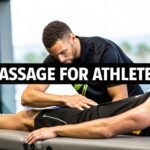
So, what’s the secret weapon in an elite athlete’s toolkit? It's not always the latest gear or some revolutionary training fad. Often, it's a dedicated commitment to massage therapy, a critical piece of the puzzle for boosting recovery, preventing injuries, and maintaining peak physical condition. Top-tier competitors don’t see it as an indulgence; they treat it as an essential strategy for a long, successful career and a serious competitive edge.
Why Elite Athletes Swear By Massage Therapy
Ever wonder how professional athletes manage to stay at the top of their game, season after season? It’s not just about talent or grueling practice sessions—it's about smart, calculated maintenance. For these competitors, their bodies are finely tuned engines, and targeted massage is the essential service that keeps them running at full power.
Think about it this way: every intense workout puts incredible stress on your muscles, leading to tiny tears, inflammation, and knots. If you let that build up, you’re paving the way for burnout, nagging pain, and the kind of injuries that can sideline you for good. This is precisely where a massage for athletes becomes an absolute necessity.
By proactively managing muscle health, athletes don't just bounce back faster—they build a more resilient, durable body. This shifts massage from being something you do after you're hurt to a powerful tool for building a long and successful career.
To give you a quick snapshot of what we'll cover, here are the core advantages that make massage a non-negotiable for serious athletes.
Key Benefits of Athletic Massage at a Glance
| Benefit | Impact on Athletic Performance |
|---|---|
| Faster Recovery | Reduces muscle soreness, allowing you to return to training sooner and with greater intensity. |
| Injury Prevention | Addresses muscle imbalances and tightness before they escalate into serious problems. |
| Enhanced Flexibility | Loosens tight muscles and connective tissues, improving your overall range of motion. |
| Improved Circulation | Increases blood flow to deliver more oxygen and nutrients to your hard-working muscles. |
| Psychological Boost | Eases pre-competition anxiety and improves focus, giving you a mental edge. |
Each of these benefits contributes to a stronger, more consistent athletic performance, which we'll explore in more detail.
A Competitive Edge Backed By Results
The real-world proof is undeniable when you look at athletes at the highest level of sport. In one study of elite soccer players during a demanding 35-day tournament, the athletes overwhelmingly reported that regular sports massage was vital for keeping up with the intense schedule and recovering between games. You can read more about these findings on scienceofmassage.com.
It's this mindset—treating massage as a performance tool—that truly separates the good from the great. It empowers athletes to:
- Train Harder and More Consistently: By cutting down on delayed onset muscle soreness (DOMS), you can get back to high-impact training much faster.
- Improve Mobility and Flexibility: Massage is fantastic for releasing tight fascia and working out stubborn knots, which directly translates to a better range of motion and more fluid movements.
- Reduce the Risk of Injury: It helps correct muscular imbalances before they become chronic issues, keeping your body aligned and ready to perform under pressure.
Adopting this professional approach is a game-changer. Once you fully grasp the link between muscle health and your athletic output, every massage session becomes a direct investment in your performance. You can explore our detailed guide to uncover all the benefits of sports massage. For elite athletes, it’s not just about feeling good—it’s about gaining a distinct physical and mental advantage over the competition.
How Massage Unlocks Better Athletic Performance
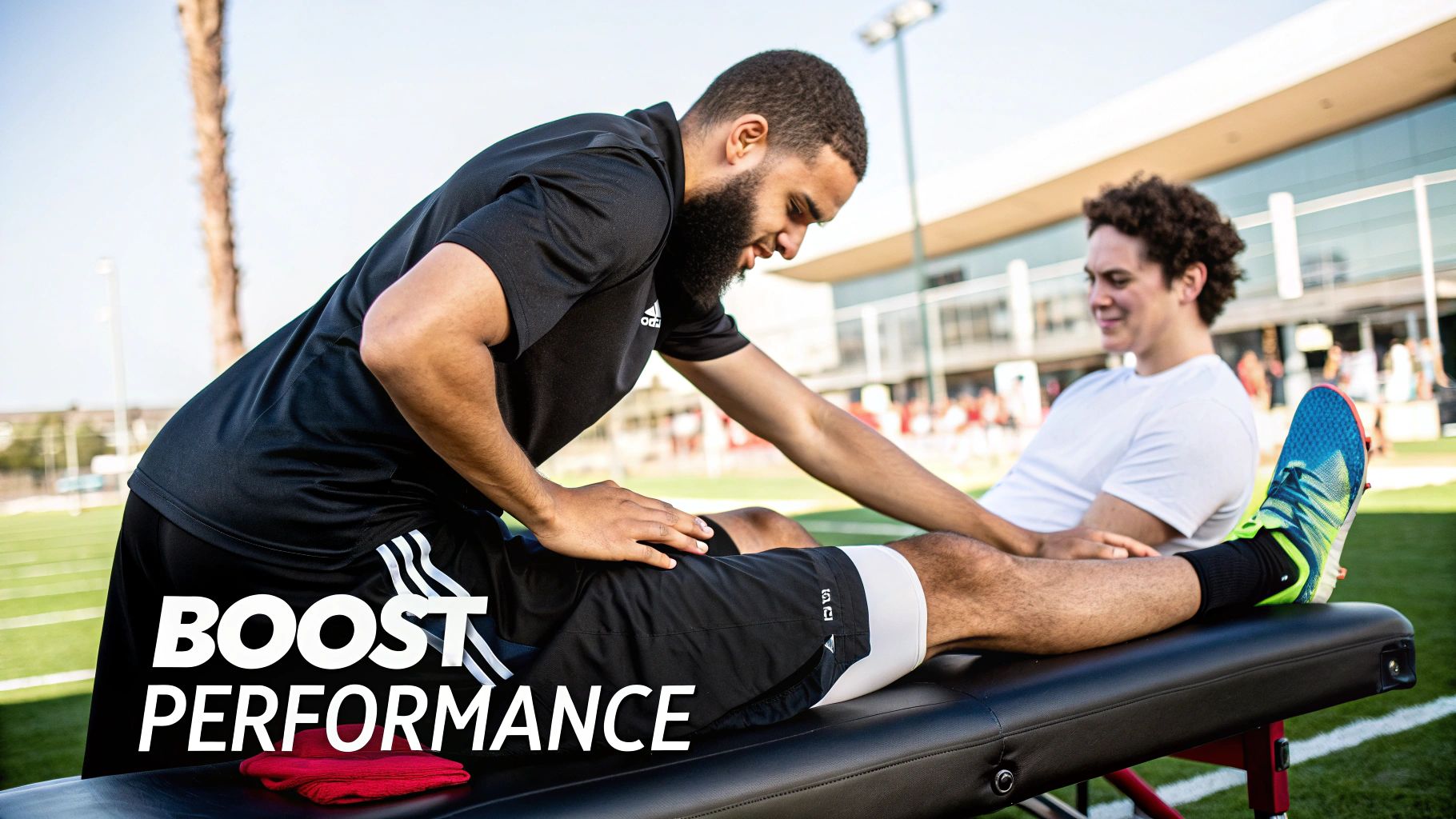
To really get why massage is so vital for athletes, we have to look beyond the "feel-good" factor and see what’s actually happening inside your body. It's not just about relaxation; it’s a powerful physiological tune-up that creates real, measurable gains on the field, court, or in the gym. Every session is an investment in your body's ability to perform and endure.
Think about a stubborn knot or a chronically tight muscle. It's a lot like a hopelessly tangled pair of headphone wires. When they’re knotted up, they can't do their job—they're constricted, short, and basically useless. In the same way, muscle knots and adhesions choke off your range of motion, limit your power, and block blood flow, creating a bottleneck that holds you back.
A great massage therapist acts like a master detangler. Through skilled pressure and specific techniques, they manually break down those adhesions, release the built-up tension, and help the muscle return to its proper, functional state. This is ground zero for unlocking your body's full potential.
Boosting Circulation and Flushing Out Waste
One of the first things you'll notice from a good massage is a major boost in circulation. As the therapist works on a muscle, the pressure physically pushes blood through congested areas, which then allows fresh, oxygen-rich blood to flood in. This isn't just a fleeting sensation; it has a huge impact on your recovery.
After a hard workout, your muscles are loaded with metabolic byproducts like lactic acid. This is a big reason you feel that familiar ache and stiffness known as DOMS (Delayed Onset Muscle Soreness).
Simply put, massage acts like a manual pump for your body's circulatory and lymphatic systems. It speeds up the process of clearing out all that metabolic junk that slows down muscle repair and makes you feel sore for days.
This "flushing" effect is a game-changer. It’s why you can bounce back faster from tough workouts, letting you train more consistently and effectively.
Calming Your Nervous System for Better Recovery
Top-level performance isn't purely physical—it's also directed by your nervous system. Your body has two main modes: the "fight-or-flight" state (sympathetic nervous system), which is on full blast during intense activity, and the "rest-and-digest" state (parasympathetic nervous system), which handles all the crucial recovery and repair work.
You can’t stay in that high-alert state forever. Real recovery only happens when you can shift into that parasympathetic mode, and massage is one of the best ways to flip that switch. The rhythmic pressure and hands-on work send signals straight to your brain, telling it that the "threat" is over and it's safe to power down.
Making this shift has several key benefits for an athlete:
- Lowers Stress Hormones: Massage is proven to reduce levels of cortisol, the main stress hormone that can sabotage recovery and muscle growth.
- Increases Relaxation Hormones: At the same time, it ramps up the production of feel-good hormones like serotonin and dopamine, improving your mood and sense of well-being.
- Reduces Muscle Guarding: When your nervous system finally calms down, muscles that you were holding tense without even realizing it can finally let go.
Releasing Fascia and Improving Mobility
Finally, a truly effective massage for athletes doesn’t just work on the muscles; it also targets the fascia. Fascia is the intricate web of connective tissue that wraps around every single muscle, bone, and organ in your body. When it gets tight and sticky from overuse, injury, or even just sitting too much, it can seriously restrict your flexibility and range of motion.
Techniques like myofascial release use sustained pressure to gently stretch and loosen this tissue. A great analogy is to imagine trying to work out while wearing a shirt that's two sizes too small. You’d be fighting it with every move. Releasing tight fascia is like getting a shirt that fits perfectly—suddenly, you can move freely, powerfully, and without restriction. This improved mobility is absolutely essential for executing movements with proper form and avoiding injuries down the road.
Choosing the Right Massage for Your Sport
Picking the right massage is a lot like choosing the right equipment for your sport—you wouldn't see a javelin thrower training with a shot put. Different massage techniques are designed for very different outcomes. To get the most out of your session, you need to understand which one aligns with your athletic goals. A massage for athletes isn't a generic, one-size-fits-all service; it's a targeted tool for performance.
Just like you wouldn't use the same game plan for every opponent, you shouldn't use the same type of massage for every physical need. The gentle, flowing strokes of a Swedish massage are fantastic for general relaxation and boosting circulation. On the other hand, a deep tissue session is built to break down chronic knots and stubborn, deep-seated tension. The best choice depends entirely on what your body is telling you at that specific moment in your training cycle.
This image gives you a quick visual breakdown of the most common massage techniques that are relevant to athletes.
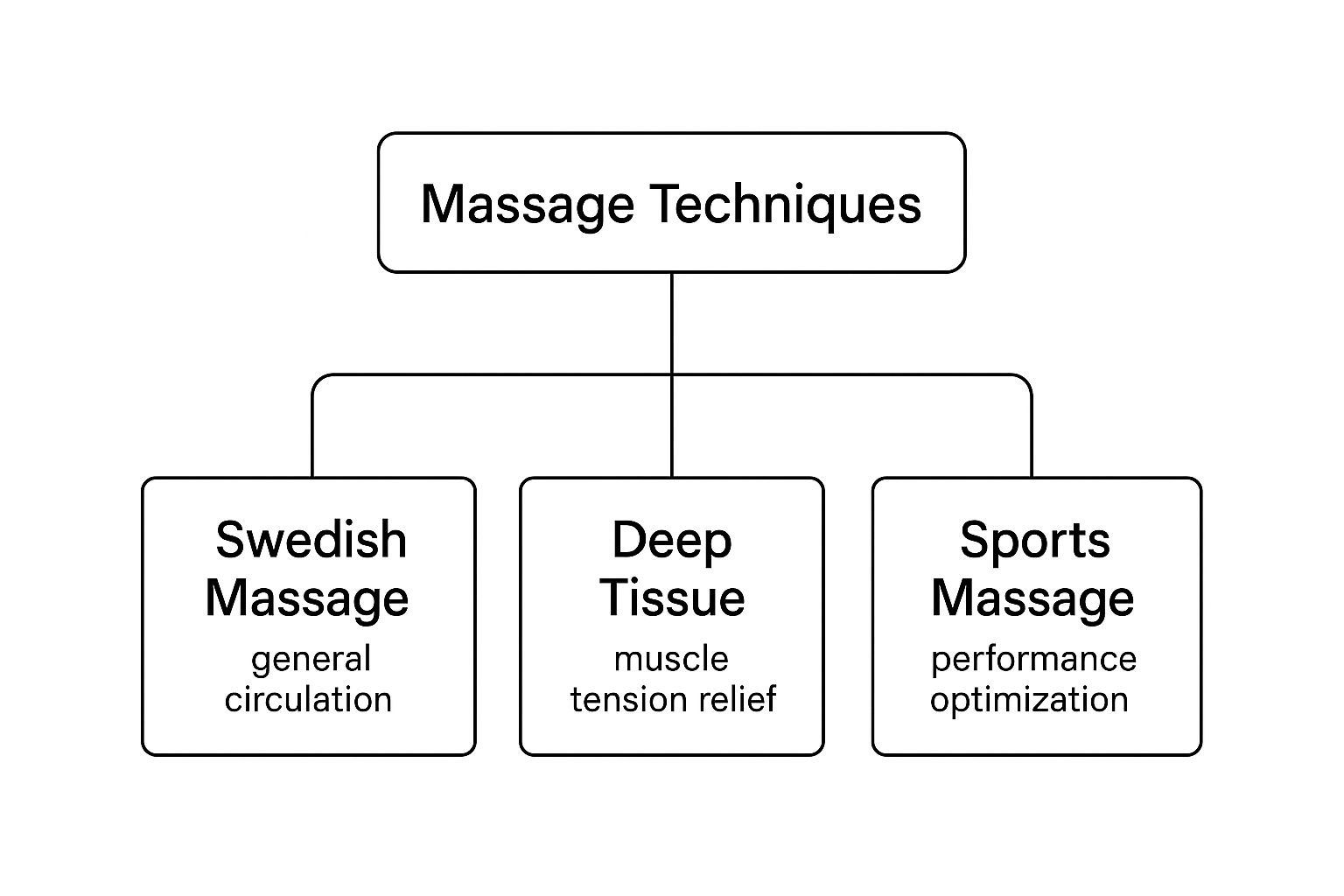
As you can see, each modality really does serve a distinct purpose, ranging from broad relaxation to highly specific performance tuning.
Deep Tissue for Chronic Tension
Think of deep tissue massage as the specialist you bring in for a really tough job. This technique uses slow, firm pressure to work on the deeper layers of your muscle and the connective tissue, or fascia. It’s the perfect choice when you're wrestling with stubborn tightness, old injuries, or dense knots that just won’t respond to lighter work.
This approach is especially helpful for athletes in sports that demand powerful, repetitive movements—think weightlifting or rowing—where muscle adhesions can easily build up over time. By breaking down those adhesions, deep tissue massage helps get your normal movement patterns back on track and can offer relief from persistent pain.
Sports Massage for Peak Performance
While sports massage often uses deep tissue techniques, it's really in a category all its own. What truly sets it apart is how it’s adapted to your athletic calendar. A skilled therapist will adjust the entire session based on whether you're in the middle of a heavy training block, getting ready for a big event, or recovering from a competition.
For any serious athlete, this is the most targeted approach you can get. Research backs this up, with one study showing that 47% of athletes felt significant relief from muscle tension after a sports massage. On top of that, 24% noticed less muscle stiffness and faster recovery times, which directly impacts your ability to train effectively. You can learn more about the differences between Sport Massage Vs Deep Tissue to see which is a better fit for your immediate needs.
Specialized Techniques for Specific Issues
Beyond these more common types, therapists often have other specialized methods in their toolkit to address very precise problems.
- Trigger Point Therapy: This is all about applying direct, isolated pressure to a specific "trigger point"—that's the technical term for a muscle knot—to get it to release. It's like finding the master switch to turn off a whole circuit of pain and tightness.
- Myofascial Release: This technique uses gentle, sustained pressure to stretch and free up the fascia, which is the web of connective tissue that surrounds all your muscles. It's incredibly effective for improving your overall mobility and relieving widespread tightness that feels like it's everywhere at once.
The key takeaway here is simple: The "best" massage is the one that directly addresses what you need right now. Are you sore from a brutal workout? Stiff and anxious before a race? Or dealing with an old, nagging pain point? Your answer points you to the right approach.
For example, a marathon runner might benefit from a lighter Swedish massage a few days before a race to boost circulation without causing any deep muscle soreness. After the race, however, a more focused sports massage would be the better call to kickstart recovery and address any new issues that popped up. To dig deeper into these differences, you can check out our guide on sports massage vs. regular massage.
Ultimately, the most important thing you can do is communicate openly with your therapist. Let them know your training schedule, your goals, and what you're feeling. That conversation is the key to getting the results you’re after.
When to Get a Massage for Optimal Results
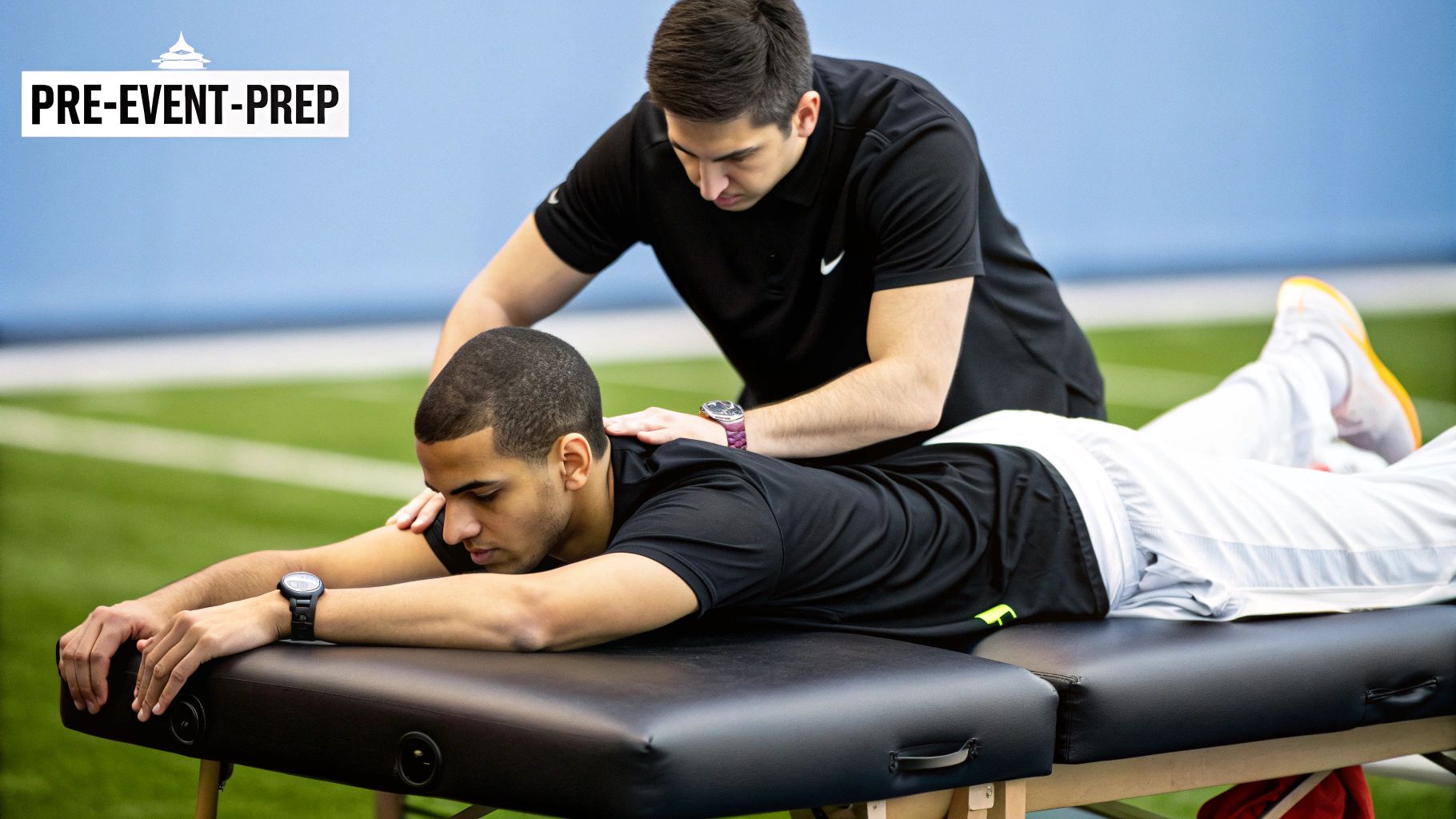
Knowing when to get an athletic massage is every bit as crucial as knowing which type to get. Timing isn’t just a minor detail; it’s a strategy. Schedule a session at the wrong time, and you could feel sore and sluggish on game day. But get it right, and you can boost your performance and dramatically speed up your recovery.
Think of it like fueling your body. You wouldn't down a huge meal right before a sprint, but you also wouldn't run a marathon on an empty stomach. Massage timing works the same way. The goals of a massage before a big competition are completely different from a session afterward, and understanding this difference is the key to unlocking the best results.
By lining up your massages with your training and competition schedule, you can turn this powerful therapy into a genuine competitive edge. This approach helps you sidestep common mistakes and ensures every session is pushing you closer to your goals.
Pre-Event Massage: The Energizer
A pre-event massage is all about preparation, not deep correction. These sessions are quick, light, and invigorating, usually done anywhere from a couple of days to just a few hours before you compete. The focus is on stimulating your muscles, not digging into deep, chronic knots.
The whole point is to increase blood flow, wake up the nervous system, and improve your flexibility without leaving you with any soreness. Your therapist will use techniques like brisk strokes, light stretching, and gentle shaking to prime your body for peak performance.
Think of it as a dynamic warm-up delivered by a professional. It's designed to get your muscles firing and ready for action, giving you a physical and mental boost right from the start.
Getting a deep tissue massage too close to an event is a classic rookie mistake. It can leave your muscles feeling tender and sluggish precisely when you need them to be at their sharpest. Save that deep work for your recovery days.
Post-Event Massage: The Recovery Accelerator
After you’ve pushed your body to its absolute limit, the focus shifts entirely to recovery. A post-event massage, ideally done within 24 to 48 hours after your competition or a brutal workout, is your best first defense against serious soreness and fatigue.
Here, the pace slows way down. The techniques are all geared toward calming your body. The therapist uses flushing strokes to help clear out the metabolic waste that builds up during intense exercise, which is essential for reducing inflammation and kickstarting the healing process.
This session also helps your nervous system switch from its high-alert "fight-or-flight" state back to "rest-and-digest" mode—a non-negotiable step for real healing. Getting this kind of targeted work can seriously shorten your recovery window, something we cover in our guide on sports massage for recovery.
Maintenance Massage: The Foundation of Your Season
While event-specific massages are critical, the true secret to long-term athletic success is the maintenance massage. This is the consistent, regularly scheduled work you do throughout your training season. It’s the foundation that prevents small aches from turning into major, season-ending injuries.
During these sessions, your therapist can finally address the cumulative wear and tear of training. They'll work on chronic knots, help correct muscle imbalances, and improve your overall mobility. This is the time and place for deep tissue and trigger point therapy, since you can safely resolve lingering issues without worrying about being sore for a competition.
How often should you get one? It really depends on the individual, your sport, your training load, and how your body recovers. Some athletes get a massage weekly, while others might go a few times a week during a particularly intense training block. By working with a therapist to align these sessions with your training calendar, you're building a proactive strategy that keeps you healthy, resilient, and performing at your best all season long.
Finding a Therapist Who Understands Athletes
The person applying the pressure matters just as much as the technique itself. While any massage can feel good, a true massage for athletes demands a therapist who genuinely gets the unique strain you put on your body. Finding the right professional is the key to getting the results you’re after.
Think of it this way: you wouldn't hire a general fitness instructor to dial in your competitive swimming stroke. The same logic applies here. You need a massage therapist who speaks the language of athletic recovery and can become a real partner in your training.
A great therapist can spot subtle imbalances, knows where you are in your training cycle, and customizes every single session to what you need that day. This transforms massage from a luxury into a strategic weapon in your performance toolkit.
What to Look For in a Sports Therapist
When you're searching for a therapist, you need to look for solid proof that they're equipped to handle an athlete's body. Don't be shy about asking for their credentials or inquiring about their background—a true professional will be proud to share their qualifications.
Start by looking for these tell-tale signs:
- Specialized Certifications: Look for credentials that go beyond a basic massage license. Certifications in sports massage, clinical massage, or orthopedic massage are a good indicator they’ve invested in advanced, specific training.
- Experience with Athletes: Ask them if they work with athletes often. Even better, do they work with athletes in your specific sport? A therapist who mainly provides relaxation massages for office workers probably isn't the best person to tackle your chronic hamstring issue.
- A Deep Understanding of Anatomy: They need an expert-level command of kinesiology and biomechanics. This is what allows them to connect the dots and trace your nagging shoulder pain back to an underlying imbalance in your hips.
The goal is to find someone who sees you as an athlete, not just a client. Their approach should be analytical, performance-focused, and collaborative, with the clear objective of helping you achieve your physical goals.
Critical Questions to Ask a Potential Therapist
Once you've found a candidate who looks good on paper, a quick conversation can tell you everything else you need to know. Treat it like an interview. After all, you’re hiring them for a vital role on your performance team.
Here are some non-negotiable questions to ask:
- How do you change your approach for an in-season vs. off-season athlete? Their answer will immediately reveal if they understand the critical role of timing and intensity in a training year.
- Can you describe your experience working with [Your Sport] athletes? This is a direct way to find out if they’re familiar with the common strains and injury patterns your body endures.
- What techniques do you use to address issues like muscle adhesions or restricted fascia? This question helps you understand their toolkit and whether they’re skilled in methods like trigger point therapy or myofascial release.
- How do you determine the right amount of pressure for an individual athlete? A great therapist works with you, not on you. They should stress the importance of open communication to make sure the pressure is therapeutic, not just painful.
Finding the right person might take a bit of legwork, but the payoff is huge. A skilled therapist who truly understands your athletic journey is one of the best investments you can make in both your performance and your longevity in the sport.
Effective Self-Massage for Daily Recovery
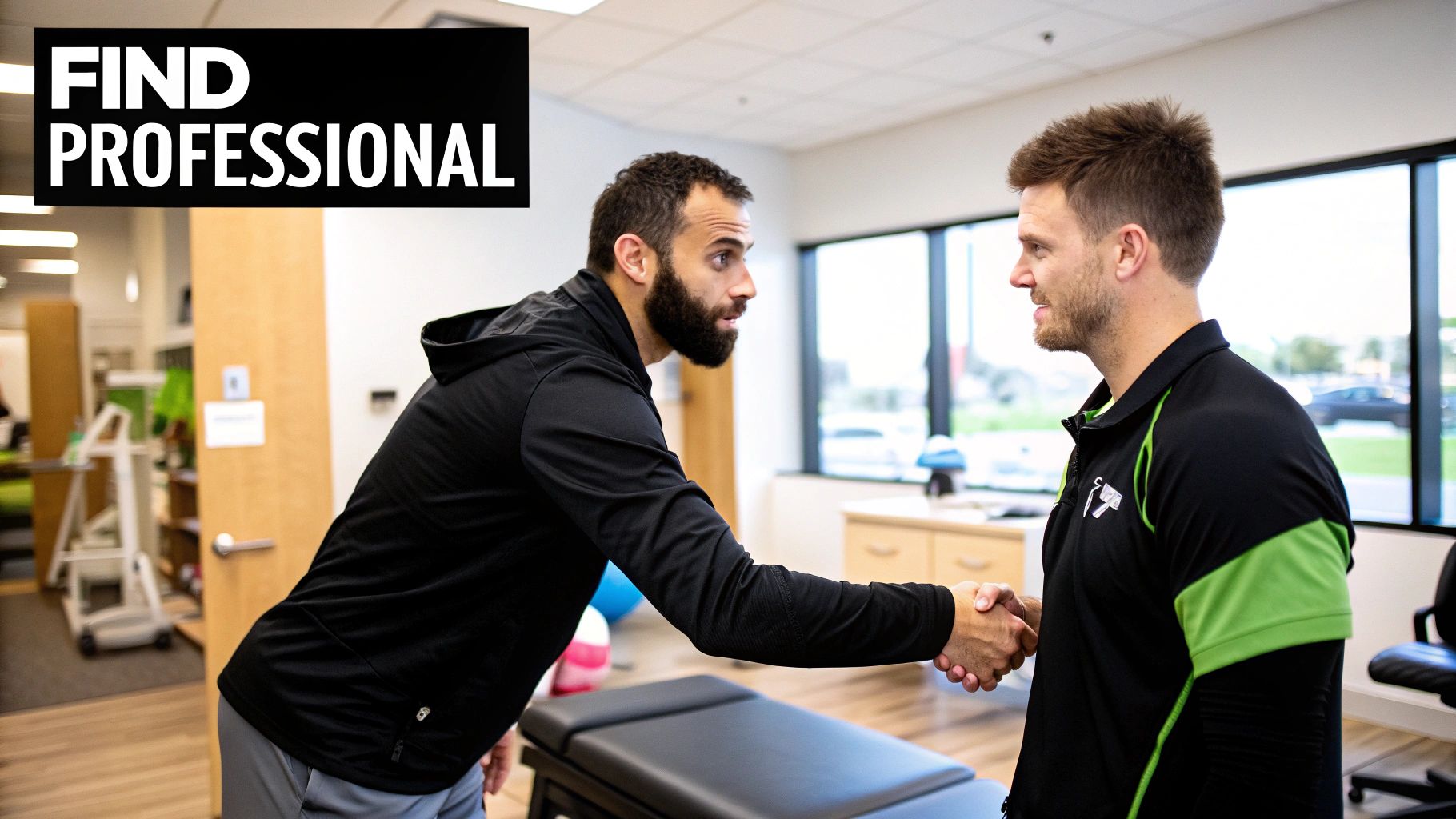
While getting a professional massage is a fantastic way to maintain your body, what you do between those sessions is where the real magic happens. Think of your daily self-care not just as a bonus, but as your secret weapon for managing soreness, staying mobile, and making the benefits of your professional therapy last.
This is about turning recovery from a passive event into an active, daily practice. With tools like foam rollers, massage balls, and percussion massagers, you can take control, addressing tightness as it appears and stopping minor aches from becoming bigger problems.
Using a Foam Roller for Large Muscle Groups
There's a reason the foam roller is a classic. It’s the perfect tool for ironing out the big, workhorse muscles—your quads, hamstrings, back, and calves—that take a beating during training. Imagine you're smoothing out wrinkles in your muscle fibers before they have a chance to set.
To really get the most from your roller, it's all about technique:
- Position the Roller: Get it under the muscle you're working on (like your quads) and use your hands and feet to support your weight.
- Roll Slowly: This is key. Aim for about one inch per second as you move along the muscle. Rushing is a common mistake that just skims the surface instead of getting deep.
- Pause on Tender Spots: When you hit a sore spot, don't just roll over it. Stop and hold that pressure for 20-30 seconds. You can even add small movements, like bending and straightening your knee, to help the muscle fibers release.
Pinpointing Knots with a Massage Ball
Foam rollers are great for covering broad territory, but for the tricky, stubborn knots, you need a precision tool. This is where a massage ball—whether it's a simple lacrosse ball or one made for therapy—really shines. It's fantastic for digging into hard-to-reach spots in the glutes, shoulders, and chest.
A massage ball allows you to apply direct, focused pressure on a specific knot, breaking it up in a way a foam roller just can't. It’s like using a fine-tipped pen to get the details right instead of a big, clumsy marker.
For example, to get into your glutes, you can sit on the floor with the ball placed right under the tight spot and gently roll on it. To release your shoulders, try standing with your back to a wall, pinning the ball between your shoulder blade and the wall to apply that targeted pressure.
Mastering the Massage Gun for Rapid Relief
Percussion massagers, often called massage guns, are all about speed. They deliver quick, powerful pulses deep into your muscle tissue, a technique known as percussive therapy. This can rapidly boost blood flow, help break down adhesions, and soothe soreness almost instantly. But using one correctly is crucial for safety and effectiveness.
Here are a few best practices to keep in mind:
- Start on a Low Setting: Always begin on the lowest speed. See how your muscles respond before you even think about cranking up the intensity.
- Keep it Moving: Don't press down hard or let the gun linger on one spot for more than a few seconds. You want to "float" it over the belly of the muscle.
- Avoid Bones and Joints: This is non-negotiable. Never use a massage gun directly over bony prominences, joints, or your neck. Stick to the fleshy, muscular areas.
By bringing these tools into your daily routine, you take the driver's seat in your own recovery. This consistent self-care works hand-in-hand with your professional massage for athletes, creating a complete system that keeps your body ready for whatever you throw at it.
Common Questions About Massage for Athletes
Once you start thinking about adding massage to your training, the practical questions usually start popping up. It's one thing to understand the theory, but another to know exactly how it fits into your schedule and what to expect. Let's clear up some of the most common questions athletes ask.
First on the list for many is a simple but important one: Is this going to hurt?
Does Sports Massage Hurt?
A proper massage for athletes should feel productive, not painful. Sure, you'll likely feel some discomfort—especially when your therapist is zeroing in on a stubborn knot or a tight spot—but it should never be unbearable. The old "no pain, no gain" philosophy definitely doesn't apply here.
A good sports massage works with your body, not against it. The whole point is to coax the muscle into releasing tension, not to brute-force it into submission.
Think of the pressure as a productive conversation with your muscles. It needs to be firm enough to get a response, but not so intense that your body tenses up to fight it. Open communication with your therapist is key; they can and should adjust the pressure to a level that feels effective for you.
How Soon Can I Train After a Massage?
This really depends on the kind of massage you just had. Timing is everything when it comes to maximizing either your performance or your recovery.
- After a light, pre-event massage: You're good to go. These sessions are designed to warm up the muscles and get you ready for action, so you can train or compete right away without any downtime.
- After a deep tissue or recovery massage: You need to give your body a break. A good rule of thumb is to wait 24 to 48 hours before you tackle another intense workout. This window gives your muscles the time they need to settle down and reap the full benefits of the deep work.
Of course, light activity like a walk or some gentle stretching during this recovery period is perfectly fine and can actually help the process along.
What Should I Do After My Massage?
What you do after your session can make a huge difference in how much you get out of it. A few simple steps will help lock in the benefits and have you feeling your best.
Number one is to hydrate. Your massage helped release metabolic byproducts from your muscle tissue, and drinking plenty of water helps your body flush all of that out.
Also, be sure to avoid any tough workouts for at least 24 hours after a deep massage. Give your muscles a real chance to heal. If you want to take it a step further, an Epsom salt bath later that day is a great idea. The magnesium helps soothe any leftover soreness and amplifies the relaxation, setting you up perfectly for your next performance.
The team at La Moon Massage and Facial is dedicated to helping you reach peak performance and recover effectively. Our experienced therapists truly get the unique demands on an athlete's body and are here to support your goals. Experience premium massage therapy designed to soothe your mind and rejuvenate your body.
